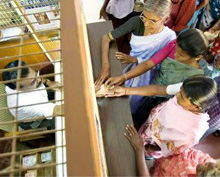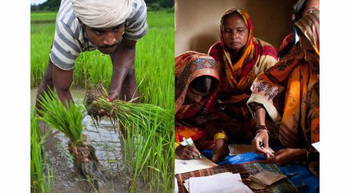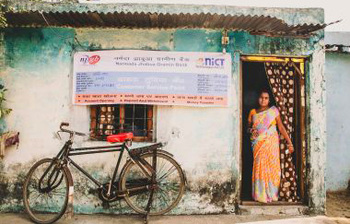Development of rural finance
Programme description
Title: Rural Financial Institutions Programme
Commissioned by: German Federal Ministry for Economic Cooperation and Development (BMZ)
Country: India
Lead executing agency: Ministry of Finance, Department of Financial Services, Banking Division
Overall term: 2009 to 2015

Context
The majority of people in rural India have no access to demand-oriented banking services which might help them to improve their economic situation. This is especially true of poorer households, smallholder farmers and women. Cooperative banks and other regionally active banks, as well as credit cooperatives and self-help groups would be able to provide financial services for these population groups. However, such institutions generally have only low operative and innovative capacities. For this reason, the Government of India has charged the National Bank for Agriculture and Rural Development (NABARD) with the implementation of programmes to promote rural finance and financial inclusion.
Objective
Rural financial institutions offer demand-oriented financial services for smallholder farmers, women and poorer households.

Approach
Partner in the programme is the development bank NABARD, which is responsible for the supervision, refinancing and promotion of the rural finance system. The partners promote the rural credit cooperatives, microfinance provided by banks through self-help groups, and the financial inclusion of poorer households by banks.
The programme experts advise state governments, banks and non-government organisations, and they arrange training for employees of NABARD, the credit cooperatives and self-help groups. This, and the application of new model solutions and technologies, contributes to the financial inclusion of the rural population.
NABARD disposes over funds which it uses for training, technological innovation and the expansion of the programme activities (EUR 190 million from 2009 to 2013). These measures have so far reached 488 rural banks and about 200 million members of credit cooperatives and self-help groups. The programme cooperates with the German Association of Cooperative Banks (DGRV) and the German Academy for Cooperatives (ADG).
Results
Rural cooperative credit system: Since 2008 the rural cooperative credit system, which consists of 92,000 institutions with 120 million members, has been able to improve its performance, by standardising its systems for accounting, auditing, training and counselling. One particular success has been the creation of a national institute with currently 4,360 institutional members, which now controls the quality of training in the sector and certifies the professional competences of employees. By establishing advisory units in cooperative banks (114 to date), the programme has helped to improve the business development of the primary cooperatives. The proportion of cooperative banks achieving a rating of at least ‘sufficiently sound’ has increased from 66 to 97%. Many cooperatives have increased the range of services for their members. The value of loans disbursed has doubled and the share of members borrowing has increased from 37 to 45%.
Microfinance through self-help groups and financial inclusion: Since 2008 the number of members of self-help groups holding deposits in banks has increased from 50 to 90 million. 82% of the members are women and 56% of the groups have outstanding bank loans. The range and quality of banking services for self-help groups has been improved though the development of demand-oriented products and the employment of their members as banking agents at village level. On behalf of two banks, about 70 women now provide banking services to 18,600 clients in 286 villages. New technologies enable the women to provide previously unavailable services such as money transfers.

Nine further banks now plan to replicate this approach. Membership in self-help groups and their role as bank intermediaries strengthen the position of women in households and village communities. Studies show that 92% of the women feel empowered by joining a self-help group. Meanwhile, 70% of the group members are satisfied with the banking services, 25% of them have increased their incomes, and the expenditure on education and health has increased by 34%.